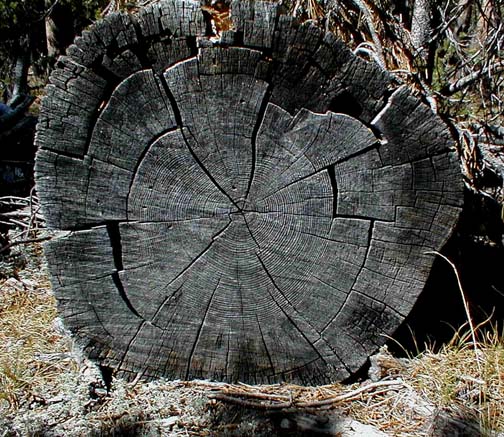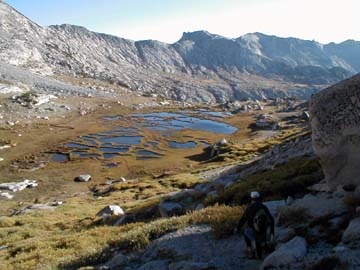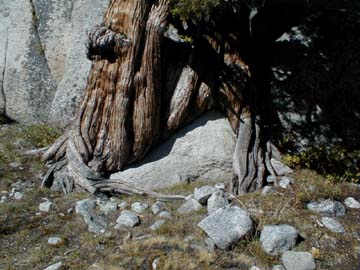The cycle of the seasons

Tree rings record good growing seasons for this fallen ponderosa
pine.
The cycle of the seasons

Tree rings record good growing seasons for this fallen ponderosa
pine.
When you walk along a trail, you will often see the ends of logs that have been cut to keep the trail clear. Sometimes you can see the yearly growth rings etched into the ends of the logs. Each ring represents a year of growth. In the spring and summer with ample water and sunlight the tree will grow fast and add a thick ring of softer wood, but in the fall and winter when the days get cold and the water turns to ice, the groth slows and the tree adds a harder, often darker layer. With the passage of decades the softer wood wears away more quickly, and the hard wood rings stand out. In many trees the layers stand out as alternate light and dark colors. To find the age of a tree in years simply count the rings.
Not all trees have rings. In the tropics the growing conditions are so uniform year round that the trees often have no rings.
In addition to recording the age of the tree, the rings record the growing conditions. In a good growing season the tree adds a thick ring, but during a drought or cold spell the rings are thinner. Some years alpine trees have no rings at al, this means that there was no growing season at all.
Plant Succession.

A lake high in Yosemite Park is becoming a
meadow.
Look at the lake in the photo above. Notice the pattern of grassy ridges that snake through the lake. It reminds me of human made rice paddies on Japanese mountains. However these grass ridges are natural. The watery places are shallow and mud filled. Sediment is slowly filling the lake.
Grass is growing in the sediment. The grass serves to catch more sediment each year expanding the parts covered by grass and shrinking the lake.
Notice that a dark line passes next to the lake on the far side. This is the stream that drains the glacial cirque to the left. It amazes me that the stream misses the lake entirely. This probably explains why this lake features such a rare pattern of grass ridges.
Plants Crack Rocks apart.

Juniper tree growing in a crack near Olmstead Point,
Yosemite.
Notice the large Juniper tree above. It is hundreds of years old. The tree started to grow in a crack between a granite ridge and a nearby rock. As the tree has slowly expanded its girth it has prized apart the rock and the cliff. Now the tree is enveloping the rock in its roots.
To Time Index
|
Scientific Explorations with Paul Doherty |
|
4 October 2000 |